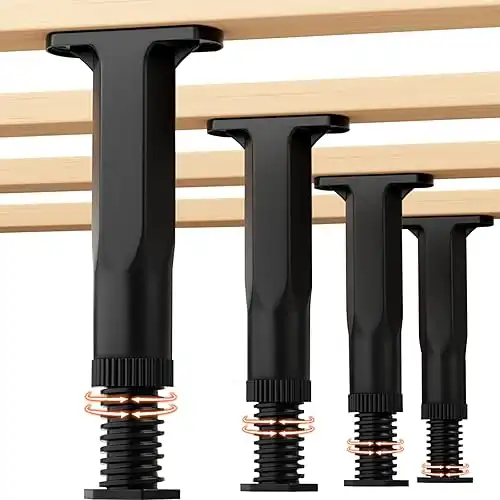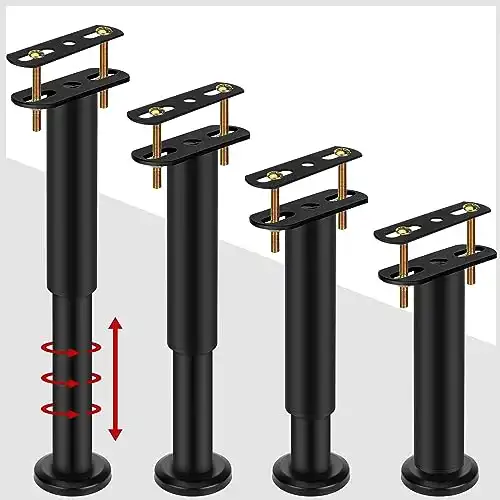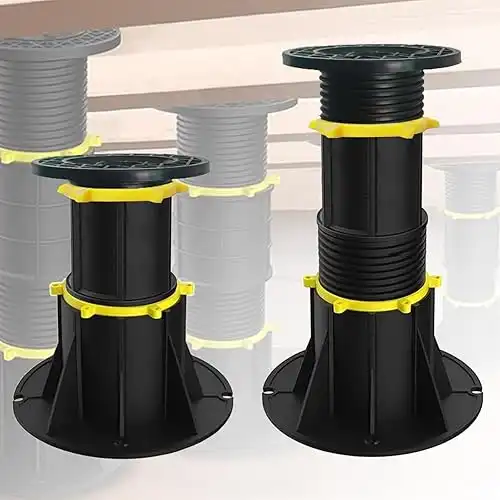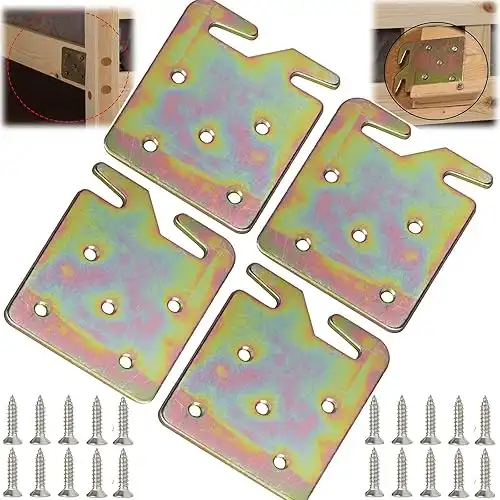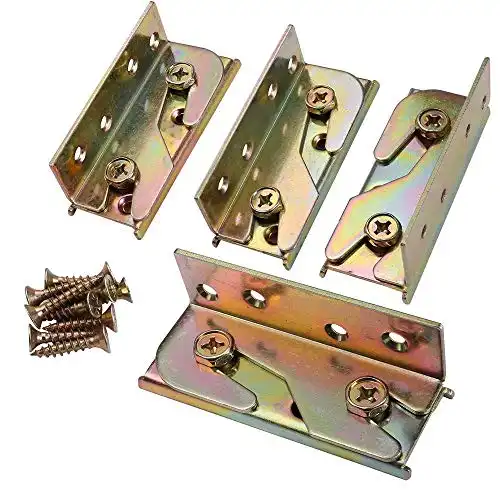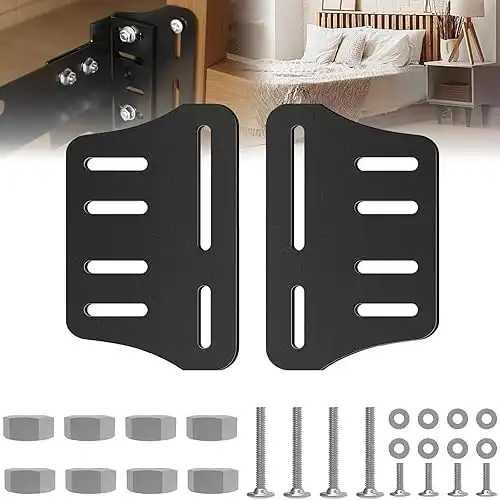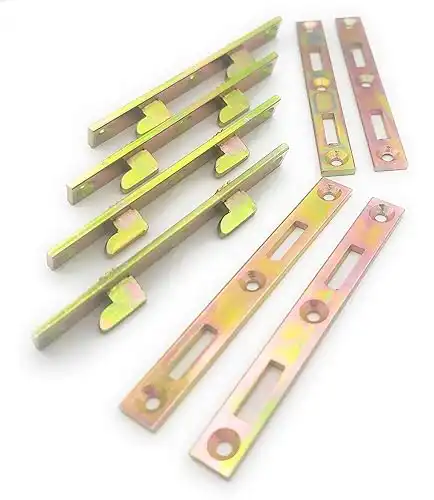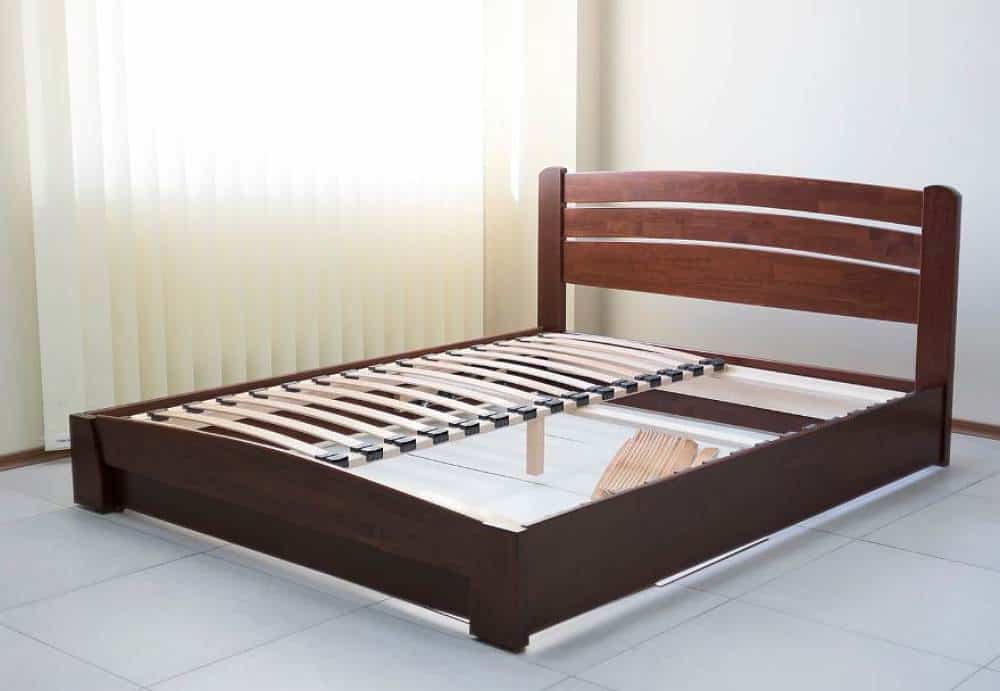
Table of Contents
Bed Support Legs – More is Better
Well, okay… within reason. (Why is it always in the middle of the night that the bed hits the floor? But, I digress…)
Always add at least one under a slat and on bigger beds add two support legs to each slat. This is a major reason why beds meet the floor unexpectedly.
If you have a queen or king bed, definitely consider the bed’s weight and then the distribution of the body weights. On the larger beds, stagger the support legs under the slats—for example, on a queen, place them with one centered leg on one slat, the next slat with two two legs, equidistant from each other. On a king bed, you should consider two legs on each slat.
Preferably, on a queen or king sized bed, you have a center support beam. If one didn’t come with it – consider installing one or having it installed. “An ounce of prevention….”
Alright, let’s dive into the world of bed support legs! You might not think about them much, but these little components play a big role in keeping your bed sturdy and comfy. There are various types of bed support legs, each with its own set of pros and cons. Let’s break them down:
1. Adjustable Bed Support Legs
Pros:
- Versatility: These legs can be adjusted to different heights, making them suitable for various bed frames and accommodating uneven floors.
- Ease of Use: Simple to install and adjust without needing specialized tools.
Cons:
- Stability Concerns: If not properly secured, they might become unstable over time.
- Durability: Depending on the material, some adjustable legs may wear out faster, especially with frequent adjustments.
2. Fixed Height Bed Support Legs
Pros:
- Sturdiness: Being fixed, they often provide solid and unwavering support.
- Durability: Fewer moving parts mean less chance of wear and tear.
Cons:
- Lack of Flexibility: Once installed, you can’t adjust the height, which might be an issue if you change your bed frame or room setup.
- Floor Compatibility: May not sit evenly on uneven floors, potentially causing wobbling.
3. Center Support Legs
These are additional legs placed in the middle of the bed frame to provide extra support, especially for larger beds.
Pros:
- Enhanced Support: Prevents sagging in the middle of the bed, extending the life of your mattress.
- Weight Distribution: Helps in evenly distributing weight, which is crucial for king or queen-sized beds.
Cons:
- Installation Complexity: Might require more effort to install, especially if your bed frame wasn’t initially designed for center supports.
- Floor Contact Issues: Some center support legs are designed not to touch the floor until weight is applied. If adjusted incorrectly, they can break when the bed is moved. reddit.com
4. Decorative Bed Legs
These legs are designed to add an aesthetic appeal to your bed.
Pros:
- Aesthetics: Enhances the overall look of your bed and bedroom decor.
- Variety: Available in numerous designs and finishes to match your style.
Cons:
- Potentially Less Supportive: Some decorative legs prioritize looks over function, possibly compromising on support.
- Cost: High-quality decorative legs can be more expensive.
5. Metal vs. Wooden Support Legs
The material of the support legs also plays a significant role in their performance.
Metal Legs:
Pros:
- Strength: Generally stronger and can support more weight.
- Durability: Less prone to warping or cracking over time.
Cons:
- Aesthetics: May not provide the warm look that wooden legs offer.
- Potential for Noise: Can be squeaky if not properly installed.
Wooden Legs:
Pros:
- Aesthetics: Offers a classic and warm appearance.
- Flexibility: Slight natural flex can absorb minor movements.
Cons:
- Durability: Can be susceptible to warping or cracking, especially in humid environments.
- Strength: May not support as much weight as metal legs.
6. Short vs. Tall Bed Legs
The height of your bed legs can influence both functionality and aesthetics.
Short Bed Legs:
Pros:
- Stability: Lower center of gravity can make the bed feel more stable.
- Accessibility: Easier for pets or individuals with mobility issues to get in and out of bed.
Cons:
- Storage Limitation: Less under-bed storage space.
- Aesthetics: Might make the room feel more cramped, especially in smaller spaces.
Tall Bed Legs:
Pros:
- Storage Space: Provides ample under-bed storage options.
- Aesthetics: Can make a room feel more open and airy.
Cons:
- Stability Concerns: Higher center of gravity might make the bed feel less stable.
- Accessibility: Can be challenging for pets or individuals with mobility issues.
In conclusion, choosing the right bed support legs depends on your specific needs, preferences, and the design of your bed frame. Consider factors like adjustability, material, height, and aesthetics to find the perfect match for your bedroom setup.
Bed Hardware Joints & Fasteners
Bed connectors are essential hardware components that join different parts of a bed frame, ensuring stability and durability. Choosing the right type of connector is crucial for both the bed’s structural integrity and ease of assembly or disassembly. Below is an overview of common bed connectors, along with their pros and cons.
1. Hook-and-Pin Connectors
These connectors consist of metal hooks attached to the bed rails that slot into pins or plates on the headboard and footboard.
Pros:
- Ease of Assembly and Disassembly: Allows for quick setup and takedown without the need for tools, making them ideal for situations where the bed may need to be moved or stored frequently.
- Strong Vertical Support: Provides robust support, especially in the vertical direction, ensuring the bed remains stable under weight.
Cons:
- Potential for Lateral Movement: May allow slight side-to-side movement if not precisely fitted, which can lead to a less rigid structure.
- Wear Over Time: Repeated assembly and disassembly can cause wear on the hooks and pins, potentially reducing their effectiveness.
2. Bolt-and-Nut Connectors
This traditional method involves bolts passing through the bed rails into threaded inserts or nuts in the headboard and footboard.
Pros:
- High Rigidity: Creates a very rigid connection, minimizing any movement and enhancing the bed’s overall stability.
- Durability: Metal bolts and nuts are durable and can withstand significant stress without degrading.
Cons:
- Complex Assembly: Requires tools and can be time-consuming to assemble and disassemble, which may not be ideal for frequent moves.
- Visible Hardware: Bolts may be visible on the exterior of the bed frame, which could be aesthetically unpleasing to some.
3. Bed Rail Brackets
These are metal brackets mounted on both the bed rails and the headboard/footboard, allowing the components to slide or snap into place.
Pros:
- Ease of Use: Facilitates straightforward assembly without the need for specialized tools.
- Strong Connection: Provides a secure and stable connection when properly installed.
Cons:
- Alignment Sensitivity: Requires precise alignment during assembly, which can be challenging.
- Potential for Loosening: Over time, brackets may loosen, especially if the bed is moved, necessitating periodic tightening.
4. Dowel Connectors
Wooden dowels are inserted into corresponding holes in the bed components, often used in conjunction with glue.
Pros:
- Concealed Connection: Provides a seamless look with no visible hardware.
- Cost-Effective: Dowels are inexpensive and easy to source.
Cons:
- Less Durable: Wooden dowels may not provide the same level of strength as metal connectors and can degrade over time.
- Permanent Assembly: When glued, disassembly becomes difficult without causing damage.
5. Metal Bed Frame Fasteners
Specialized fasteners, such as corner brackets or clamps, are used to join metal bed frames.
Pros:
- Strong Metal-to-Metal Connection: Ensures a sturdy and durable joint.
- Adjustability: Often allows for adjustments to ensure a tight fit.
Cons:
- Complexity: May require specific tools and expertise to install correctly.
- Potential for Noise: Metal components can creak if not properly tightened.
In conclusion, selecting the appropriate bed connector depends on factors such as the desired ease of assembly, aesthetic preferences, and the need for durability. Understanding the pros and cons of each connector type can aid in making an informed decision that ensures both the longevity and stability of the bed.

